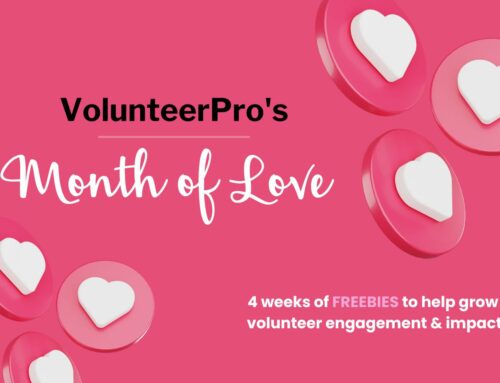
How to Convince Your Boss to Approve Your Resource Requests
If your requests for approval for volunteer resources have been shot down by your boss, you no doubt understand how deflating it can be and how it can tank your motivation.
Believe me, I’ve been there. I’ve even experienced this in well-funded environments where I ran my own budget. Or at least I thought I did. Until, one day, I was blindsided.
I was planning a statewide volunteer conference at a government agency where I worked. I was the program director and managed a $3.4 million dollar budget, 15 staff, and many sub-grantees throughout the state. Most other departments in my agency had no idea my department had the largest budget. They just saw us as that “little volunteer program” down the hall.
Yep, even well-funded program leaders get the blues.
For our conference, we planned to purchase polar fleece vests for our volunteers. We had not hosted a statewide conference for several years, and we wanted to acknowledge the dedication of our steadfast supporters, many of whom had been contributing time for years.
Having a “uniform” of sorts would identify them as they fanned out to deliver services across the communities. What’s more, the vest would help them see themselves as a part of a larger team, most of whom they had never met. I had recently instituted many improvements to the program and our volunteers had weathered the tides of change. I wanted to acknowledge their resilience and celebrate our unity.
To manage the event, I formed a small committee of volunteers and employees. We researched options and chose a vest option that was affordable, but nice. I double checked to be sure we had the budget and that it was an allowable expense under our federal grant. Everything looked good, so I placed the order.
About a week later, I was in a meeting with agency leadership where I regularly reported on our program progress. Out of the blue, the fiscal department manager stated they had concerns about the vest purchases, because of how it would “appear to the public.”
I was completely blindsided. I had already secured my boss’s approval and, more often than not, as a responsible program director, I was left to manage my own budget.
Apparently, we had been vetoed … in a very public way.
It cut me to the bone. In the moment, I was completely unprepared to advocate for my team. I was caught flat footed and was not prepared to state my case. I felt angry, and (right or wrong) I also blamed myself for not being a better leader.
The opportunity to build better team cohesion was lost.
The vest order didn’t go through, and I had to deliver the news to my conference committee. Despite my best efforts, some of our volunteer leaders walked away questioning whether the agency really supported them.
Not fun.
But, I also learned a valuable lesson. The experience taught me that I needed to be prepared to make the case for our needs — I needed to get better at thinking on my feet, too.
So, this blog post is dedicated to that lesson, with the hope that you don’t have to experience the humiliation of having the rug pulled out from under you. And, if it’s already happened to you, that you can prevent it next time … or at least weather the storm.
Your First Step: Strengthen Your Mindset

First things first. Let’s start with your mindset.
If you don’t believe your organization will truly benefit from what you are asking for, then don’t ask for it. It’s as simple as that. No need to waste limited resources. No need to waste time trying to convince your boss.
But, if you believe your request can make a real difference in your agency’s results, then don’t apologize for asking.
You are engaging in what you were hired to do. Your mandate as a leader — no matter where you sit on the org chart — is to consistently and relentlessly seek ways to improve your results and gain efficiencies.
In my case, I might have been able to win the debate if I’d had more confidence in what the investment was expected to achieve.
So, don’t be shy about asking for what your program needs. But, also come fully prepared when you’re ready to make your ask. Be able to draw a straight line between the ask and the result.
Your Next Step: Resist the Poverty Mindset
In many nonprofits, we are encouraged to buy into a “poverty mindset.” We believe we need to scrape and struggle to get by — that only through suffering will we succeed. We accept it as a reality.
This limiting belief holds us back. It keeps organizations from leveling up and impacting their cause.
The poverty mindset simply isn’t true. Consider the most successful nonprofit you know — are they getting by on a pittance? It’s doubtful.
In order to grow, you must invest in building capacity, beyond the knowledge and tools you already have, or you will remain stuck. This also includes taking a few risks and trying things that may or may not work.
You cannot grow your nonprofit by thinking small and barely surviving on a shoestring.
[Indulge me with a little tough love here: The truth is that no one wants to support the kind of organization that is barely making due. People want to give their time and money to organizations that have big ideas and are striving to achieve big things in the world. People want to back winners, not losers. By thinking small you are actually driving people away. ‘Nuff said.]
But, you already know this, right?
You’ve got BIG ideas for your volunteer strategy. You also know you need to convince your boss to build capacity and achieve your dreams.
Capacity Building Reaps a Positive Return
Sometimes doing more with less requires a little up front investment.
Capacity building involves purposefully investing in activities or tools that strengthen an organization’s ability to better fulfill its mission. These activities might include — strategic planning, updating your communications strategy, technology upgrades, operational improvements, board development, internal research, or building staff skills to engage volunteers more effectively.
Research tells us these kinds of investments can reap rewards. One study demonstrated organizations that engaged in capacity building grew their budgets by about 10%. In addition, those that specifically targeted financial capacity (such as hiring a grant writer or developing an in-depth fundraising plan) were not any more effective than other types of capacity building — all types benefitted the organizations.
So, when you are trying to convince your boss to approve resources for your program, remember you are seeking a way to build the capacity to achieve greater impact. When I was requesting my vests, I believed they would help strengthen our culture of teamwork. But, in the moment, I wasn’t able to articulate my rationale. So, the answer was “no.”
Convince Your Boss: How to Overcome Their Objections to Requests for Resources

So, here’s what I recommend the next time you need to convince your boss to approve funding for support, resources, program learning, or improvements.
There are three key objections we often hear from our audience when they request approval to join our VolunteerPro membership community or enroll in one of the online courses available in our Volunteer Management Academy: lack of budget, wrong timing, and spending money on their department isn’t fair to other staff.
People share their disappointment with us, and we can’t help but feel their pain. We are confident our solutions will help their organizations grow, but their leadership just can’t see it. We wonder what other opportunities they are missing.
So, let’s convert this grief into something actionable.
Here’s how to combat the three common objections to requests for resources and convince your boss to say yes. With all of these, the core problem is that your boss doesn’t see the ultimate value of the thing you are requesting. You’ve got to educate them about the transformation it can help you achieve.
Your boss probably has a favorite “go to” objection you often hear. Be prepared to address it directly when you make your next ask.
Objection #1: We don’t have the budget.
 This excuse is the most common and enduring. But, it’s rarely true.
This excuse is the most common and enduring. But, it’s rarely true.
Think about something you’ve badly wanted in the past. You’ve figured out a way to pay for it, right? We’re not talking about going into deep debt here. But, if an organization really, truly believes an intervention will get them traction, they will find a way to pay for it.
Volunteer engagement offers great ROI for nonprofits and research shows volunteers positively impact your agency’s bottom line. So, sometimes it helps to explain in clear terms how the funding invested will be recouped. If you know your stats, you can make some informed predictions (see the Helpful Metrics section below).
You can also convince your boss by better describing the current agency pain point in compelling terms and explaining how your request directly solves that problem. How have you positioned your request? What examples can you share about others who have found success using this resource? What case studies can you share?
Finally, speak more to the benefits of the resources (the results or what the resource can do for you) versus the features (a description of what it is), your ask will be more effective. We call this “describing the candy, not the wrapper.” When candy companies sell their products, they don’t list out the candy’s ingredients, they describe how delicious it is and paint a picture of how it will make you feel.
Objection #2: It’s not the right time.
 This is a common objection for people who are risk averse. They believe your agency or department “isn’t ready” or “we don’t have time in our busy schedules.” This often means they are afraid to take the leap.
This is a common objection for people who are risk averse. They believe your agency or department “isn’t ready” or “we don’t have time in our busy schedules.” This often means they are afraid to take the leap.
At this point you have to make them feel more secure in their decision, but also make it clear what you will miss out on if you don’t act now. Not all resources will be available later, or they may require a larger budget if you wait. So, you need to convince your boss to get off the fence.
You can do this by illustrating the “opportunity cost.” What will you lose out on if you wait? For example, if your agency is experiencing increasing volunteer turnover, what will happen if this goes unaddressed? Or, what consequences will you face if you don’t have resources to set up a volunteer training soon? How many volunteers will you lose to other agencies?
Finally, if you want to take a more positive approach, you can use a technique called “future pacing.” Describe what the end of the rainbow looks like if you get the resources you need. Link this to your agency’s (or boss’s) biggest pain points and worries.
Use “imagine if …” statements.
For example, “Imagine if we were able to keep all of our far flung volunteers up to date and enthusiastic using today’s technology?” or “Imagine what it would it feel like if we didn’t have to worry about filling our volunteer shifts every week and instead had a reliable pipeline of people ready to help?”
Objection #3: It’s not fair to the other departments (or staff).
 Finally, executives often categorize capacity building or a resource request as “professional development” rather than viewing it as something that benefits the entire organization.
Finally, executives often categorize capacity building or a resource request as “professional development” rather than viewing it as something that benefits the entire organization.
So, make sure you’re able to convince your boss the solution can help people both on your team and outside it. All the better if you can link your request directly back to the goals in your agency’s strategic plan.
If you are requesting funds for training, yes, it will benefit you personally. But, will building your skills to better manage and lead also impact your co-workers, volunteers, customers, and mission? Of course, it will. You’re a dedicated and conscientious professional. So, when you invest your time into something, you’re darn well going to make it work, right?
In addition, take responsibility for sharing the wisdom you gain, or the improvements you make, as a result of additional resources. If you’ve been approved to attend a conference, offer to conduct a brown bag lunch to share what you learned and its implications for your organization. Or, write an article for your agency newsletter. And, use your insights to generously coach your colleagues and offer advice.
Helpful Metrics to Have at the Ready
Finally, before you try to convince your boss, try to have key metrics ready. These can help you describe, using data that executives love, where you’re at now and why it’s a growing concern for your agency.
Here are some things you might want to investigate and track at your agency:
- Annual volunteer retention rates
- Average volunteer length of stay
- Percentage of unfilled volunteer positions or roles (unmet capacity or need)
- Number of volunteer complaints and complaint trends
- Conversion rates (from website visitor to applicant to trainee to active volunteer)
- Annual financial contributions to your agency by current volunteers
- Percentage of volunteers who make financial contributions to your agency
With these metrics, you can begin painting a picture of current volunteer engagement trends and your agendy’s needs. Then, armed with these data, you can focus your request on the opportunity to level up, expand your reach, deepen volunteer engagement, or prevent a crisis as opposed to merely asking for resources to keep achieving the same results.
You may not have all of these now, but work towards having them ready in the future — especially those you feel will resonate most with your boss. This smart practice can pay off later.
P.S. This Works for Volunteer Recruitment, Too!
Much like trying to convince your boss, you can also purposefully respond to concerns from potential volunteers.
You don’t have to take “no” as a final answer. Rather, consider it an invitation to educate the prospective volunteer about all of the options. Perhaps there’s a way to accommodate their special needs or schedule?
So, similar to how you might plan your communications with your boss, take the same steps to plan for volunteer objections.
You’re likely to hear the same three to four issues come for folks. Take proactive steps to develop talking points, so you’re not caught flat-footed and feeling awkward ever again.
Let Us Know How It Goes!
The final word: Don’t waste your talents in the shade. Volunteers need you to step up.
So, if you need support or funding, dig in and get resourceful.
No matter how many times folks tell you “no,” keep pushing forward. If you give up, you’ll never get there. And, if you’ve given it the old college try and it still feels hopeless, try another agency that better understands the importance of your work.
No one said nonprofit work is easy. But, it is so worth it.
Also, be sure to celebrate and share your successes. Your stories help encourage others to take the risk and give it a try.
If you’ve been able to convince your boss and secure something special for your program by changing how you made the ask, share what you did in the comments below.
Shine your light so others can live by it. 🙂





